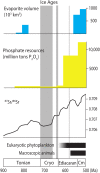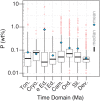Ediacaran reorganization of the marine phosphorus cycle
- PMID: 32424088
- PMCID: PMC7275700
- DOI: 10.1073/pnas.1916738117
Ediacaran reorganization of the marine phosphorus cycle
Abstract
The Ediacaran Period (635 to 541 Ma) marks the global transition to a more productive biosphere, evidenced by increased availability of food and oxidants, the appearance of macroscopic animals, significant populations of eukaryotic phytoplankton, and the onset of massive phosphorite deposition. We propose this entire suite of changes results from an increase in the size of the deep-water marine phosphorus reservoir, associated with rising sulfate concentrations and increased remineralization of organic P by sulfate-reducing bacteria. Simple mass balance calculations, constrained by modern anoxic basins, suggest that deep-water phosphate concentrations may have increased by an order of magnitude without any increase in the rate of P input from the continents. Strikingly, despite a major shift in phosphorite deposition, a new compilation of the phosphorus content of Neoproterozoic and early Paleozoic shows little secular change in median values, supporting the view that changes in remineralization and not erosional P fluxes were the principal drivers of observed shifts in phosphorite accumulation. The trigger for these changes may have been transient Neoproterozoic weathering events whose biogeochemical consequences were sustained by a set of positive feedbacks, mediated by the oxygen and sulfur cycles, that led to permanent state change in biogeochemical cycling, primary production, and biological diversity by the end of the Ediacaran Period.
Keywords: Ediacaran; biosphere; phopshorus; phosphorite; sulfate.
Copyright © 2020 the Author(s). Published by PNAS.
Conflict of interest statement
The authors declare no competing interest.
Figures



References
-
- Planavsky N. J., et al. , A case for low atmospheric oxygen levels during Earth’s middle history. Emerg. Top. Life Sci. 2, 149–159 (2018). - PubMed
-
- Crockford P. W., et al. , Triple oxygen isotope evidence for limited mid-Proterozoic primary productivity. Nature 559, 613–616 (2018). - PubMed
-
- Narbonne G. M., Gehling J. G., Life after snowball: The oldest complex Ediacaran fossils. Geology 31, 27–30 (2003).
-
- Hoyal Cuthill J. F., Han J., Cambrian petalonamid Stromatoveris phylogenetically links Ediacaran biota to later animals. Palaeontology 61, 813–823 (2018).
Publication types
LinkOut - more resources
Full Text Sources

